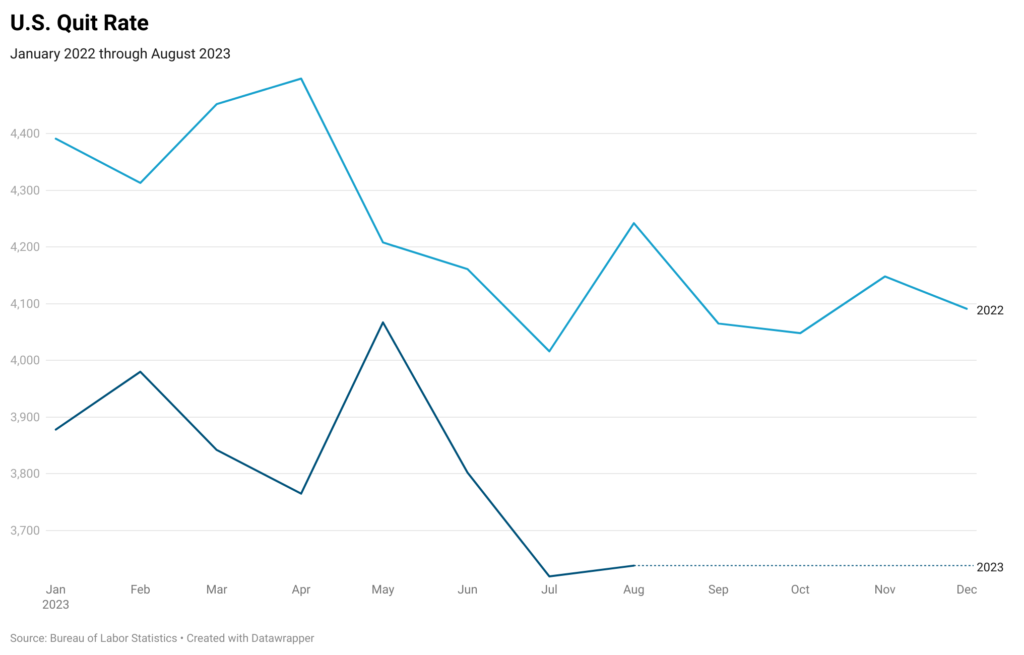Many people are left wondering if the "Great Resignation" is gone or if there are still difficulties for employers on the horizon as the business landscape changes in the wake of the COVID-19 outbreak. The phenomena, which was accompanied by a spike in employee turnover, highlighted the shifting nature of labor in the twenty-first century. However, the environment might be changing once more, necessitating adaptation and vigilance on the part of employers. This essay will examine if the "Great Resignation" has actually ended and offer five suggestions to help businesses deal with the post-pandemic turnover trends.
Revisiting The Great Resignation
The "Great Resignation" was marked by a wave of workers quitting their positions willingly, motivated by things like remote work and reassessing professional and personal priorities. The data shows the quit rates surged to over 4 million people quitting their jobs per month. This workforce trend made businesses reevaluate their talent retention plans.
Has the Wave of Resignations Slowed Down?
When I am conducting strategic workforce planning analysis for organizations, I like to take a more holistic view of data trends. I’ll also look at industry, location, other demographic and environmental trends outside of what the U.S. Bureau of Labor Statistics provides, before officially declaring the “Great Resignation” is over. However, according to the U.S. Bureau of Labor Statistics it appears the overall quit rates appear to be softening compared to 2022.

Ultimately, the effects of the "Great Resignation" are still being felt, despite the fact that some labor market dynamics are returning to normal. Employees are still looking for remote options, flexible work schedules, and a better work-life balance. Employers must take evolving expectations seriously.
The Need for Retention
The expense of turnover continues to be a problem for organizations. In terms of hiring, onboarding, and training, the cost of replacing an employee might be high. Employers must continue to be dedicated to keeping their best employees.
Where do we go from here?
5 Tips to Navigating Post-Epidemic Turnover Trends
- Embrace Flexibility: Offering flexible work options, such as remote or hybrid models, can be a crucial differentiator in attracting and keeping top talent. Flexibility reflects a company's dedication to the welfare of its workers.
- Put employee well-being first: Programs for mental health and wellbeing are more crucial than ever. Employers ought to make investments in tools that support staff in managing stress and keeping a good work-life balance.
- Advancement Opportunities: Supporting employees' professional development and progress through initiatives for upskilling and reskilling. This may improve career advancement and job happiness, lowering the incentive to look for alternatives elsewhere.
- Communication Effectiveness: Ensure clear and open communication with employees regarding the company's objectives, modifications, and future plans. Open communication can increase engagement and trust.
- Employee Involvement: Asking for input from employees on a regular basis will help you determine their satisfaction and problems. Make improvements based on their suggestions to foster an environment where staff members feel appreciated and heard.
Wrapping it up
The "Great Resignation" may have changed, but its effects continue to be seen in the workplace. Employers should maintain their vigilance, adjust to the shifting environment, and prioritize talent retention. Recognizing the continued need for flexibility, wellbeing, and professional progress is the key to success in the post-pandemic era. Employers may handle turnover trends and establish themselves as employers of choice in a competitive employment market by adhering to these guidelines.
These statistics reinforce the idea that while the initial wave of resignations may have stabilized, the impact of the "Great Resignation" endures, and employers must remain vigilant in addressing evolving employee needs and expectations. The labor market dynamics have fundamentally shifted, requiring organizations to adapt and prioritize retention strategies.
